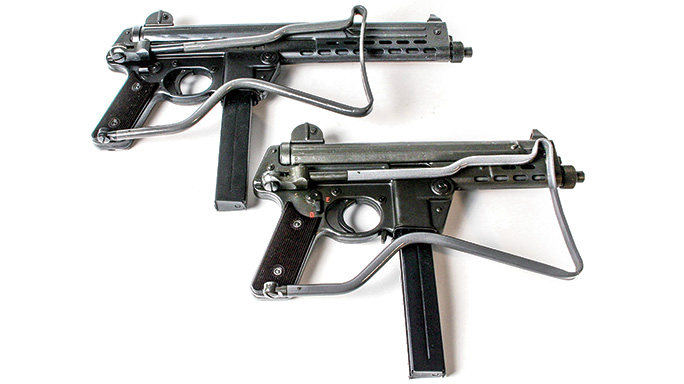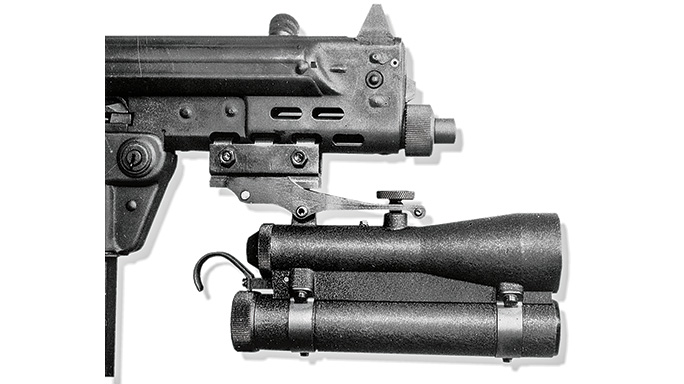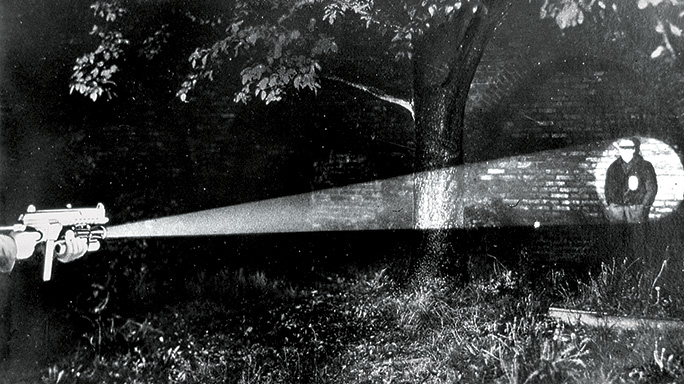In the history of European submachine guns, it is easy to overlook the Walther MP series—but that would be a mistake. While the Heckler & Koch MP5 has become such an iconic submachine gun (SMG), it is easy to forget that initially in Germany it was outpaced by another SMG that had been developed by Walther a few years earlier. Offered in two primary versions, made up of the MPL (Maschinenpistole Lang) and the MPK (Maschinenpistole Kurz)—“Lang” for long or “Kurz” for short—the weapon began production in 1963 and remained in production until 1985. However, actual development of what would become the MPL and MPK began much earlier, during the 1950s.
- RELATED STORY: Walther Uzi .22: A Weapon with History
The Walther fires from an open bolt and is of an interesting design. It is the shape of a “Lazy L,” as they would say if it were a cattle brand, as the “L” appears to be on its side. Much of the bolt’s weight is located above the bolt face. The operating spring guide rod extends through the bolt from the rear of the receiver and helps guide the bolt within the receiver. This guide rod is critical to the operation of the MP as it also guides the main spring. Cuts on the bolt keep dust or debris from clogging the action. The bolt is not captive to the cocking handle, so it remains in the forward position while the bolt is cycling.
Full-Auto Force
Advertisement — Continue Reading Below
The MPL/MPK safety lever is ambidextrous and, when in the “S” position, locks the bolt either forward or to the rear. Thomas B. Nelson’s The World’s Submachine Guns explains that the MP SMG is full-auto-only so there are only two selector positions, “S” and “F.” However, the MPLs and MPKs I have handled and fired have had a “semi-auto” setting as well. Nelson was writing about early prototypes of the MP SMGs, which may have initially only featured the two settings.
According to Nelson, the MPL/MPK’s stock could be folded to either the right or left side of the weapon. However, all of the production guns that I have encountered have a stock that folds only to the right. The ability to fold to either side would have been quite useful for security details, as the team leader, normally seated in the right front seat, could have the stock folded to the left, allowing him to quickly deploy it with his support hand (assuming he were right-handed) while exiting the vehicle. Other operators would also find the ability to deploy the stock from the left a bit faster. However, since the MPL/MPK, as produced, folded to the right, users adapted. I found it fastest for me to slap the stock with my shooting hand.
During World War II, the Germans had substantial experience in producing SMGs and assault rifles from stampings. This experience is carried over to the MP, which uses a stamping with an integral magazine housing for the receiver. The magazine is based on the proven Carl Gustaf design (Swedish K), which has a reputation for durability and reliability.
Advertisement — Continue Reading Below
The Right Tools
The MPL/MPK did not achieve wide success, though there were some military and law enforcement sales. There were even a few sales of the MPL to the U.S. Armed Forces. The SEALs used some suppressed MPs in Vietnam. I have also read that some MPs were used on the Son Tay Raid. Originally, the Delta Force used the M3 Grease Gun, but after encountering the HK MP5 with Germany’s GSG9 antiterrorist unit it adopted that weapon instead. The GSG9 had adopted the MP5 because it was the standard SMG in use with the West German Border Patrol—not the MPL/MPK. Reportedly, though, the Delta Force acquired some MPLs and MPKs during a transitional period between the M3 and the MP5.
Other government sales included those to German law enforcement agencies. Within Germany, the Navy adopted the MPL while various police forces adopted the MPL or MPK. The most well-known use of the Walther MP by German police was probably during the Munich Olympic hostage crisis. Members of the Munich police, armed with the MPL, attempted to infiltrate the scene of the hostage taking at the Olympic Village. Unfortunately, the area had not been cleared of news cameramen so the assault was televised and watched by the terrorists! It failed, but the MPL was prominently featured.
Advertisement — Continue Reading Below
I served as the tactical adviser for National Geographic Channel’s Seconds From Disaster on the Munich incident a few years ago. As part of the process I had a chance to talk with one of the German Polizei who had been part of the assault. In passing, we discussed the MPL. He informed me that they had felt outgunned since the terrorists had AK-47s. I mentioned that my experience has been that very few of the terrorists/insurgents/freedom fighters I’ve encountered actually had zeroed their AK-47s or practiced with them extensively; hence, at the ranges involved, I feel the assault team should have been able to engage effectively.
His reply was that they had qualified with the MPLs but rarely practiced with them. Basically, they were trained as patrol cops, not as a SWAT team. Because of the overall poor response to the terrorist attack, Germany formed its elite antiterrorist unit, the GSG9, the next year. The GSG9 adopted the HK MP5 and introduced it to many other antiterrorist units, thus helping it surpass the MPL/MPK within a few years.
Most of the other countries that adopted the MP chose the MPK version for its compactness. Among these were Brazil, Colombia and Venezuela. The Mexican and Portuguese navies adopted the MPL and used the SMG for many years. In fact, as of about 10 to 15 years ago, the Portuguese Marine Corps was still using the MPL. The South African Police used the MPL/MPK, but it is no longer a first-line weapon. Zimbabwe also had MPLs at one point, likely acquired from South Africa. However, Zimbabwe uses mostly AKs and other ComBloc weapons these days.
Advertisement — Continue Reading Below
Other official and semi-official units around the world have used the MPK. I had contact with various Middle Eastern close-protection teams during the 1970s and 1980s that had MPKs. In that part of the world, Germans SMGs have always been popular.
Hands On
It’s unclear how many MPLs and MPKs were produced. Based on my own experience, there seem to have been more MPKs, but that may just be those that I’ve encountered have been with agencies that want their SMGs as concealable as possible. I would estimate that I’ve fired the MPK at least three or four more times than the MPL. My estimate is that I’ve put about 600 to 750 rounds through the MPK and a couple of hundred through the MPL.
Advertisement — Continue Reading Below
I have shot these Walthers enough to make some comments about their use. One positive comes after shooting the MPK, as the barrel and other parts may be quickly removed for easy cleaning. I have found the pistol grip comfortable, but the selector switch is hard to operate with fingers that aren’t long. The selector operates with “safe” in the top position, “full auto” in the middle and “semi-auto” almost 180 degrees from safe. The latter requires a long push from full auto to semi, usually requiring the shooter to shift their grip on the shooting hand or using the support hand. Actually, though, the relatively low cyclic rate of the MPK allows firing of single shots or double-taps through trigger control after becoming familiar with the weapon.
I especially like the MPK’s sights. I find the peep quite useful at 100 yards. An interesting aspect of the MPK’s sights is that the open sight is atop the peep sight and allows the head to be up for scanning an area while allowing quick engagement. The front post is narrow enough to allow good acquisition with either the open sight or the peep. The triggerguard is open enough to allow shooters to wear tactical or other light gloves.
I like the durability of the MPK’s steel construction and shrouded sights; whether it’s in the hands while exiting a vehicle or slung while moving through a building, the Walther submachine gun is likely to take some knocks. On the other hand, the steel stampings get very cold or very hot depending on the weather. The latter is also the case when the gun is fired on full auto. As a result, the MPK can be uncomfortable to use outdoors in some cases.
Advertisement — Continue Reading Below
The MPK’s wire skeleton stock has the usual problems with such stocks. It is not comfortable against the shoulder or the cheek, though the fact that the MPK fires the 9mm round makes it less uncomfortable than it would be if firing a more powerful round. When firing on full auto, the MPK is definitely uncomfortable and hard to control. Firing bursts helps a lot. Holding the MPK steady during full-auto fire is made more difficult by the necessity to grip the front of the magazine well with the support hand. Folding the stock takes some effort and the shooter must beware that he or she doesn’t catch a finger. On the positive side, the MPK has two latches to keep the stock solidly folded.
The magazine housing is not beveled to speed up loading in combat; this would be a desirable feature, especially at night. The magazine well is forward of the triggerguard as on other German SMGs. Given that the MPK began production after the Uzi was already on the market, this was a marketing disadvantage and a tactical disadvantage, as the ability to find the magazine well in the grip on the Uzi—using the hand-finds-hand system—makes the Uzi quick for combat reloads.
In fact, Germany produced the Uzi as the MP2 on license, one other reason why there were no major German military contracts for the MP. I don’t consider the forward mag well a major disadvantage, as most of the SMGs I used during the 1970s and 1980s have them in the same position. The magazine release was usable but not especially ergonomic.
Advertisement — Continue Reading Below
Evaluating the MPK has been a trip down memory lane for me. It’s been a reminder of the days when my hair was still brown, my waist was 32 inches, I carried a Browning Hi-Power and I could work 12-hour shifts and still spend an hour or two working out in the gym. There is a tendency to compare the Walther MPK to the HK MP5, but I think that a more apt comparison is with other SMGs of the time, including the Uzi, the Beretta M12 and the Sterling, for example.
- RELATED STORY: Gun Review: Walther’s Single-Stack CCP 9mm Handgun
Despite the relative disadvantages of the MPK I’ve mentioned, when I was using it or training teams that used it, I was satisfied with it. I felt that if I had to bring it into action it would respond. It always proved reliable, which was a confidence builder.
I have to admit, too, that I always liked the MPK because it was a Walther. In fact, I carried a PPK as my backup gun during the years when I would have used the MPK. The MPK is rarely encountered today, but I would recommend that if the chance should arise to shoot one, take it. This design offers an interesting look at a very rare and intriguing German SMG.
Advertisement — Continue Reading Below
For more information, please visit Waltherarms.com.


























